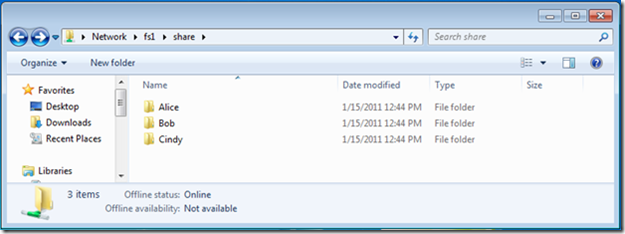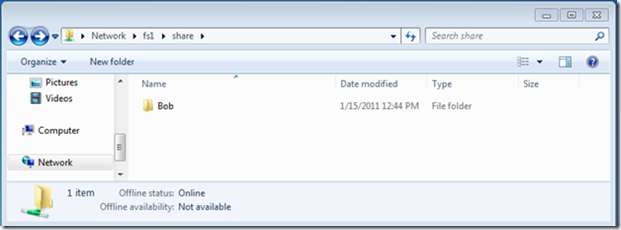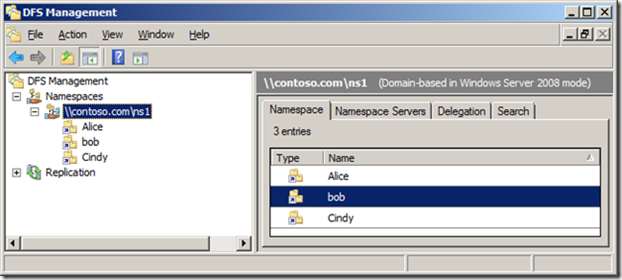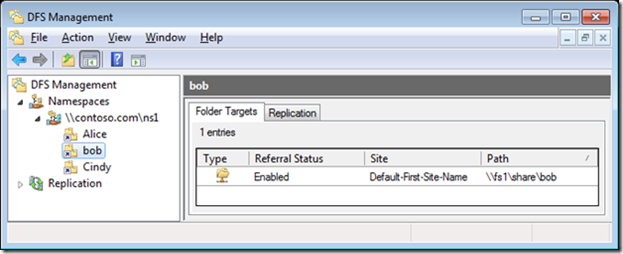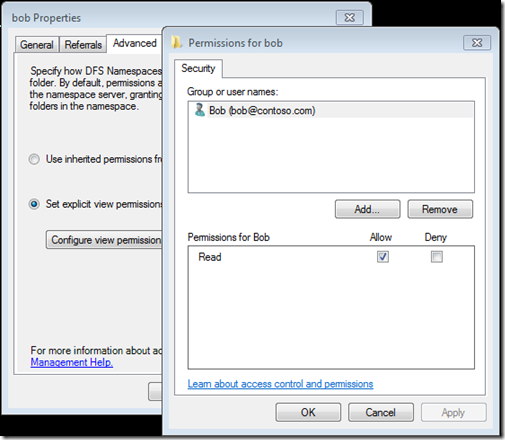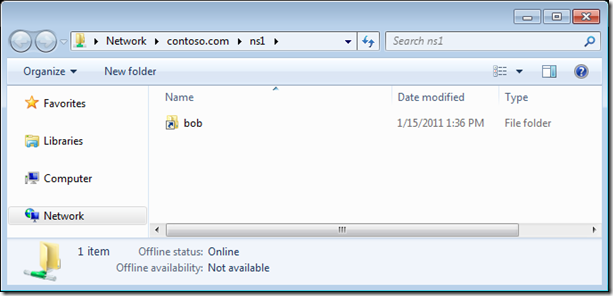Using ABE with DFS
Hello, Dave here. Today I discuss the Access Based Enumeration (ABE) feature in Windows Server and how it may be implemented with Distributed File System Namespaces (DFSN).
First you may ask, "What is ABE, and why would I want to utilize it?" By default, all folders and files will be listed in a folder, even if the browsing user doesn't have permissions to them. For example, three users (Alice, Bob, and Cindy) have folders under a share on file server ‘FS1’.
Each user's folder has permissions such that only the single user has access (icacls.exe output below):
\\fs1\share\Alice CONTOSO\Alice:(OI)(CI)F
\\fs1\share\Bob CONTOSO\bob:(OI)(CI)R
\\fs1\share\Cindy CONTOSO\Cindy:(OI)(CI)R
The following is what user “Bob” observes when browsing the UNC path \\fs1\share:
If a user attempts to open another user's folder or file within that folder, they will be met with an error as they do not have sufficient permissions. Administrators may not desire this user experience, as it may generate helpdesk calls or confuse users.
ABE is Windows Server feature which causes the server to display only the files and folders that a user has permissions to access. Once ABE is enabled on the share mentioned above, users will only see those folders for which they have access. Below is Bob's view of the share's contents, now with ABE enabled:
ABE is enabled for non-DFS shares via the "Share and Storage Management" snap-in. You may be asking if this feature may be utilized by DFS Namespaces as well. Yes it can!
ABE in DFSN has matured considerably since its original implementation in Windows Server 2003. Back then, you had to install a separate add-on component to expose the necessary UI to configure ABE on a shared folder. Then, you had to follow KB article 907458 in order to make it functional within a DFS namespace. Further complications arose from having to utilize cacls.exe on each namespace server to set link permissions and having to repeat the operation should the namespace be modified in various ways. To say the least, there was significant management overhead.
Fortunately, Windows Server 2008 and 2008 R2 supports ABE in DFSN natively. It may be utilized on a domain-based or standalone namespace such that users will only see DFSN folders for which they have permissions. NOTE: ABE requires the namespace to be in "Windows Server 2008 Mode". If you have existing namespaces that are in "Windows 2000 Server mode" (view the properties of a namespace in the DFS Management snap-in), you will need to convert them to 2008 mode. To do so, please follow the information available here.
As an example, the namespace “ns1” was created and contains DFSN folders for the three user folders discussed previously.
The DFSN folder “Bob” is configured with the target \\fs1\share\bob, as seen below:
By default ABE is not enabled on the namespace, and users are able to see all DFS folders within it. When Bob browses the namespace via the path \\contoso.com\ns1, he will see the three DFS folders defined above: Alice, Bob, and Cindy. By enabling ABE on the namespace, the DFSN service of all namespace servers will automatically enable ABE on their local namespace share and enforce the configured permissions of reparse folders automatically. You will not be burdened with having to run cacls.exe manually on each namespace server.
The commands utilized to enable ABE and set the required permissions are as follows:
dfsutil property abde enable \\contoso.com\ns1
dfsutil property acl grant \\contoso.com\ns1\alice contoso\alice:F protect
dfsutil property acl grant \\contoso.com\ns1\bob contoso\bob:F protect
dfsutil property acl grant \\contoso.com\ns1\cindy contoso\cindy:F protect
Note: The 'protect' parameter is important as the reparse folders underneath the namespace shared folder will inherit permissions by default and typically not restrict access to the DFSN folders. Also, the “abde” parameter was changed to “abe” in the 2008 R2 and Windows 7 version of dfsutil.
With a Windows 7 client or a 2008 R2 server running RSAT, enabling ABE and setting permissions may be directly performed via the DFS Management MMC. Simply open the properties of a specific DFS folder in the namespace and click the ‘advanced’ tab:
Bob would have the following view of the “NS1” namespace after ABE is enabled and appropriate permissions are set:
In the end, the permissions configured within the namespace ultimately end up on the special reparse folders found within the namespace server's share. It is the enumeration of these reparse folders which dictates if a DFSN folder is observable by a user as they browse through the namespace.
One final note: some DFSN administrators may wish to leverage ABE with a mixture of Windows Server 2003 R2 and 2008/2008 R2 namespace servers using the process detailed in KB 907458. Although possible, you must first deploy a hotfix to any Windows Server 2008 SP2 or 2008 R2 RTM/SP1 namespace servers to prevent the loss of the modified reparse folder permissions. Details about the update are available in KB 2464365.
I hope the information is helpful as you consider implementation of ABE on a DFS namespace. Happy DFSN'ing!
Dave “Honest ABE” Fisher
